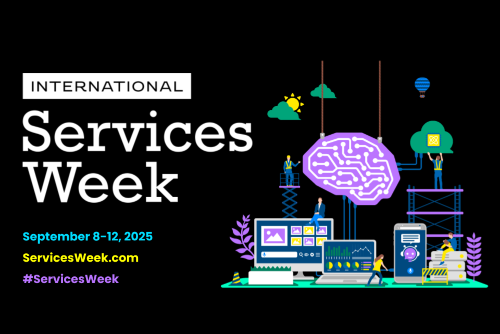Automating Services Quote-to-Cash: Emergence of CPQ for Services

According to TSIA’s 2024 Tech Stack Survey, B2B tech companies are planning major investments in technologies related to professional services. Though 66% of companies are currently using professional services automation (PSA), 75% say they have budget for additional PSA technology in the next 1-2 years. Adoption of configure price quote (CPQ) technology is even higher, 89%, yet a surprising 93% of respondents, all B2B CIOs, are planning additional investments.
Why are companies allocating budget for CPQ tools, which we typically think of in the realm of sales and product teams, and how are the needs of professional services driving this spending?
Increasing the Velocity of Professional Services
Although the adoption of PSA technology, which automates PS revenue and resource forecasting, resource management, project management, and project accounting, is high, we still see a lack of automation in the creation of PS proposals, also known as service estimates. On average, it takes 32.9 business days, over 6 weeks, to deliver a proposal. Why is PS proposal generation so complicated?
- No single source of truth. Proposals/Estimates are often created in Excel spreadsheets or Word documents, with a lot of manual reviews and approvals, usually done via email, which not only lengthens the process but makes it difficult to track where proposals are in the process.
- Disconnected systems and teams involved in quoting. Pricing is often determined by a product or service sales rep, a sales support group, or even the finance department. 39% of companies do not have a dedicated PS sales support function for assembling or generating PS proposals.
- No pricing controls or standardization in the offering. 27% of companies do not have a documented service catalog of offers and pricing for professional services, meaning sales may be making decisions on pricing and discounts with no input from PS.
We are also seeing considerable lag time with customers approving proposals. The average days for a proposal to go from quote to close is currently 56 business days, or 11 weeks. How to reduce quote to close time? Digitize and standardize workflows to allow for accuracy, interconnectivity, and scalability, which introduces more visibility and transparency for both PS execs and customers, eliminating the need for multiple communications asking for additional detail.
For PS to be more responsive to customers, turn around proposals faster, and provide more accurate proposals that customers are more willing to approve, automation is required. But despite the move to more sales automation and self-service selling being embraced by companies for subscription technology, services are often an outlier
Why Traditional CPQ Tools Don’t Work for Professional Services
I have talked to many PS execs who say their product and sales teams bringing XaaS offers to the market are investing in new CPQ, eCommerce, estimation and billing platforms that enable subscription selling. But PS rarely has a seat at the table for these discussions. And when the platforms go live, they are very product-centric, with little or no ability to quote services projects.
It is fairly straightforward to create standard bundles, configurations, and price books for products. CPQ platforms allow salespeople (or customers purchasing using self-service) to select the right mix of products and licenses to fulfil the desired outcome. Especially for cloud software, there are no physical product assets or fixed inventory to consider. But services are much more complicated. The complexity of implementation, integration, and customization can vary dramatically by industry, geography, current IT environment, level of customization of existing systems, and the business goals for the project. Plus, services projects can’t be sold without resources attached, meaning skills, experience, location, and availability of consultants must be factored into every proposal. Product-centric CPQ platforms simply weren’t built to accommodate this level of complexity.
Particularly for larger enterprise deals, the product quote may change and evolve as negotiations with the customer progresses. And every change to the product bundle or configuration can require a complete recreation of a services proposal. Without automation, as products are easier and faster to quote with CPQ tools, PS becomes even a bigger bottleneck in the eyes of the customer. When requesting what appears to be a simple change to the product bundle by the customer, they then have to wait for a month or more to receive an updated services proposal.
A Shift to Subscription Services
An additional driver for CPQ investments is the shift to subscription pricing models for PS. This model allows customers to browse a catalog of available services, often value-added services, and pay with pre-paid points or credits, creating a new stream of revenue for PS outside of traditional implementation and integration projects.
According to the TSIA Survey: Shifting to a PS Subscription Model completed in Q4 2024, over half of companies say they are piloting concepts for subscription models for PS, or are already seeing market success. To introduce a self-service approach for customers to identify and schedule these pre-defined services, an online service catalog and CPQ capabilities must be in place.
A New Breed of Services-Centric CPQ
Why are we seeing budget being allocated for CPQ technology for professional services? The reason is there are now service-centric CPQ platforms available which can streamline and automate the creation and approvals of PS proposals, cutting the time to create a proposal from weeks to hours. And since I have yet to find a traditional product-centric CPQ platform that fully supports services, PS leaders are investing in tools to streamline the proposal process, and CROs are pushing for additional technology to support subscription services to increase annual recurring revenue (ARR).
Services CPQ and estimator solutions picks up where product pricing and configuration leave off. It takes all of the bill rates, price books, project templates, discount tables, etc., available, and allows a salesperson (or customer) to select a predefined services project. They can then identify any variables to create a proposal, including a statement of work (SOW) generation, and workflows to move a proposal through your approvals process. The services estimation engine also integrates with the PSA platform to identify available resources, and ultimately to schedule the project when the customer approves the proposal. For subscription services, services estimation integrates to enterprise resource planning (ERP) to automatically deduct pre-paid points or credits.
Depending on how mature the current approach to proposals, pricing, and discounts may be, there are likely to be some processes to iron out as part of this project. As an example, companies without an existing service catalog must standardize aspects of the services business which have been handled via email and spreadsheets in the past to effectively adopt Services Estimation.
Here are a few recommendations to consider if automating PS proposals is on your 2025 roadmap:
-
- Mature your pricing and discount structure. If you are moving off manual processes and spreadsheets for all or part of the proposal process, you likely have some work to do on solidifying project definitions, templates for proposals and statements of work, and pricing and discount structures. Spend the time to get this right before the move to automation, which may take some cross-department collaboration with sales, offer creation, and finance.
- Focus on fixed price, repeatable offers. If you are primarily delivering custom projects today, making the shift toward more fixed price, predefined, repeatable projects will increase the scope of proposal automation. While there will always be some variables depending on the customer’s requirements and their IT environment, moving toward predefined projects will also encourage more “out of box” implementations, with less customization. This should ultimately enable lower cost of ownership, and less complexity, for the customer. And, defining these fixed price, repeatable offers will allow an easier transition to subscription pricing.
- Remember the customer experience. While there are business benefits to automation, including increased velocity and more accurate proposals, remember that a primary driver of eCommerce and Services CPQ is the customer experience. Customers increasingly want to self-serve, and they expect full transparency in pricing and discounting, which will reduce quote to close time. If your sales and product teams are focused on product-centric automation for subscription offers, demand a seat at the table for these conversations, and make sure services are part of the automation roadmap. Customers will notice if only part of the process is automated, and it doesn’t speak well of your PS organization if they are still working in spreadsheets in today’s digital world.
- Leverage AI. Though this blog didn’t focus on AI, leading providers are introducing AI, GenAI, and now Agentic AI features that are transforming the entire PS lifecycle. In a survey completed last year, only 11% of TSIA members were targeting pricing decision making for initial AI projects. When evaluating CPQ and PSA platforms, familiarize yourself with ever-expanding AI capabilities to automate scoping, pricing, and generating proposals, ensuring the desired margins are achieved.
Recent Articles
Maximize your Salesforce investment with Certinia






